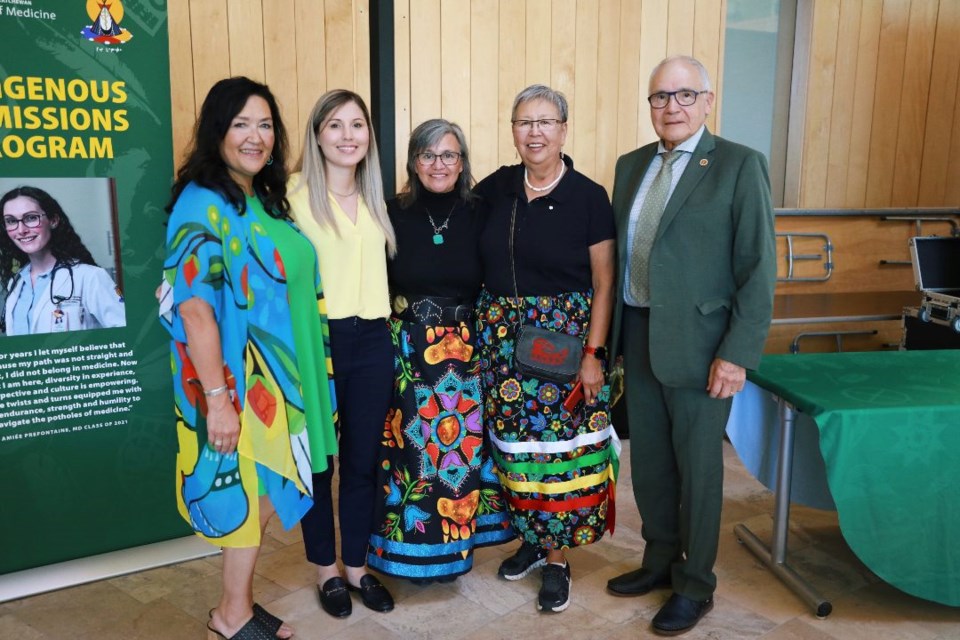SASKATOON — The University of Saskatchewan’s (USask) College of Medicine is creating a first of its kind department in a Canadian medical school, dedicated to improving the health outcomes of Indigenous Peoples in Saskatchewan through academics and education.
The Department of Indigenous Health and Wellness received University Council approval in April 2023, and will serve as a welcoming space for Indigenous health researchers, learners, and faculty in the college. Indigenous health is a priority for the college and its new department will include collaborations across the university.
“We’re creating the structure that will allow Indigenous voices to tell us where we need to go,” said Dr. Janet Tootoosis (MD), interim vice-dean Indigenous health. “We're creating a community but we're also creating a physical space where people can connect and learn about what’s happening in the College of Medicine.”
The new department will be Indigenous-led and ensure research is informed by Indigenous community needs. It will also influence how medical education and scholarship incorporates Indigenous knowledge and systems.
“It’s important that the College of Medicine has this department because Indigenous people are harmed in the health system,” said Tootoosis.
The department goals are to meaningfully address Indigenous health inequities, knowledge translation, systemic racism and the scarcity of strength-based Indigenous health research. It will also build capacity for the college to effectively respond to the Truth and Reconciliation Commission’s (TRC) Calls to Action.
Tootoosis started in her role in June 2022 with the task of establishing a new administrative home for Indigenous health in the college. With her team in the Office of the Vice-Dean Indigenous Health (OVDIH), Tootoosis led the proposal development and stakeholder engagement process. This included key consultations with the university’s governance office, provost office, and vice-president academic office.
To begin the process, Tootoosis and the OVDIH team created a working group of Indigenous and non-Indigenous faculty and staff. This working group was responsible for drafting the department proposal and engaging in stakeholder consultation.
This first step involved understanding the vision from the college’s Indigenous Health Committee (IHC), said Tootoosis. The IHC was formed more than 20 years ago to strengthen links between Indigenous world views and the medical community. The working group then engaged in robust consultation with more than 80 internal and external stakeholders including college and university leaders, Indigenous health researchers, and Indigenous leaders and communities.
“All of those (Indigenous health committee) members, past and present members were consulted. As well as internally – our leadership, our department heads, our faculty that had special interest, and externally – Indigenous communities, tribal councils and various community members,” said Tootoosis.
The community engagement process incorporated what Tootoosis refers to as “authentic community engagement,” which includes mutual learning and equal partnerships. Tootoosis stressed the importance of respectfully engaging and listening to Indigenous communities to understand the challenges from their perspective.
“We are trying to understand ‘what are those challenges’ and what – if anything – could the College of Medicine do to change the issues that we’re having,” she said. “That information will allow the college to respond in an informed manner versus sitting around a table and determining what's in the best interest for Indigenous populations.”
External stakeholder consultations took place with Indigenous leaders at the Federation of Sovereign Indigenous Nations, various First Nations Tribal Councils and Grand Councils, and Indigenous educational leaders at institutions such as the First Nations University of Canada.
After the consultation process was complete, Tootoosis presented the department proposal at the college’s faculty council in September 2022. The proposal included more than two dozen letters of support from college and university leaders, and key provincial stakeholders. The proposal received overwhelming support to move forward.
Further presentations at University Council, the Board of Governors, and Senate resulted in the department being formally approved by the university in April 2023. A celebration and formal launch for the new department was held in late September.
Now, Tootoosis and her team will focus on the first phase of implementation – staffing the department and building its capacity in collaboration, mentorship, and networking.
“The next steps really are that recruiting and engaging faculty in duties to build the department and begin to work toward meeting the department’s goals,” she said. “Along with that, there will be student supports, staff supports, networking, and we have an expansion of space.”
Tootoosis sees great things ahead.
“There is an opportunity for this department not to follow the traditional construct of a clinical department. And so that is an exciting opportunity for the College of Medicine on how we can enhance the structure to improve collaboration,” said Tootoosis.
The department will be a “transdisciplinary hub” for research, and will foster collaboration by bringing together Indigenous health researchers from across the university, she said. The combined expertise will expand research opportunities not only within the college and USask, but also across Canada.
“All of that (collaboration) is going to result in researchers advancing research, and then increasing the knowledge translation from the research,” said Tootoosis. “The research is going to become meaningful to Saskatchewan, and if it becomes meaningful to Saskatchewan, it becomes meaningful to the world.”
This gift is part of the University of Saskatchewan’s Be What the World Needs Campaign.
— Submitted by USask Media Relations
SASKTODAY.ca is Saskatchewan's home page. Bookmark us at this link.




